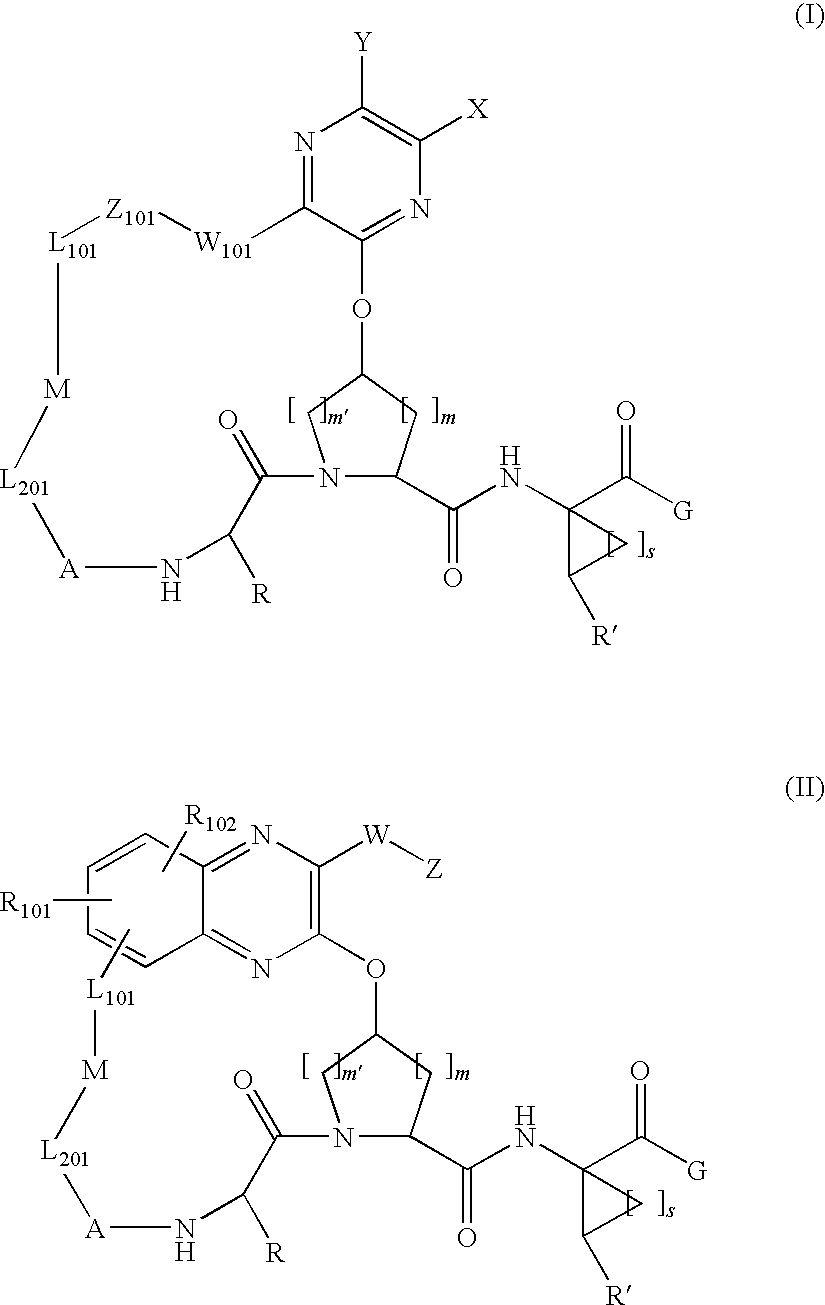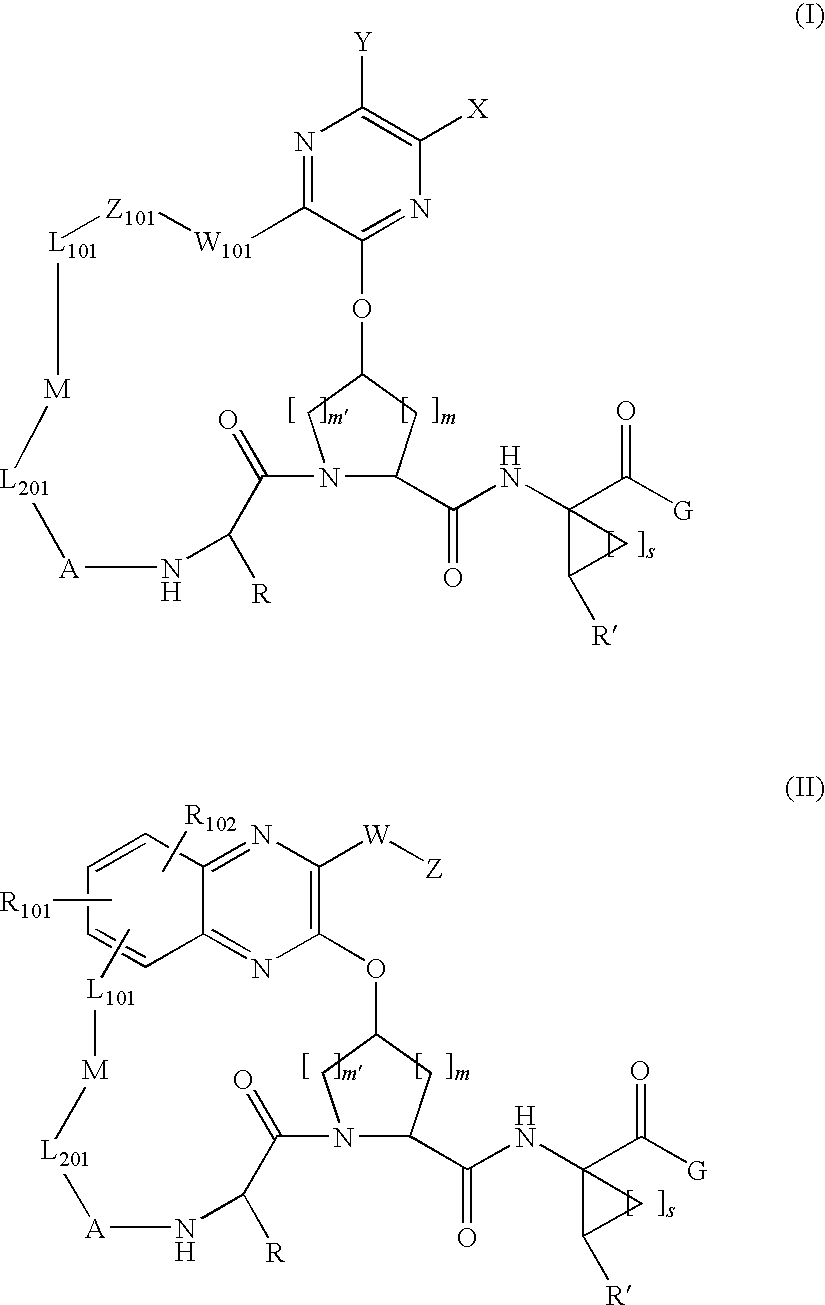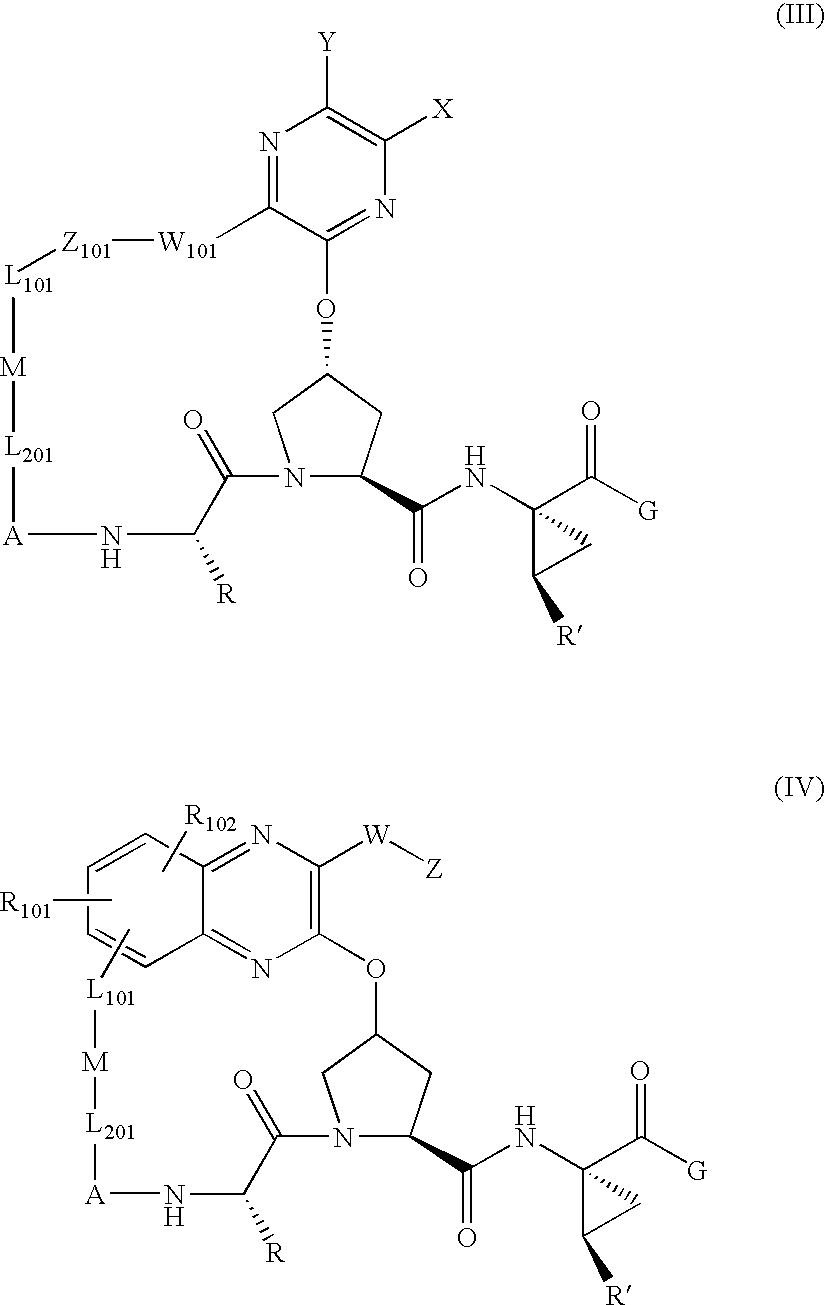Quinoxaline-containing compounds as hepatitis c virus inhibitors
a technology of hepatitis c virus and quinoxaline, which is applied in the field of new drugs, can solve the problems of interferon related side effects, inability to reproduce infectious culture systems and small animal models for hcv, and increasing public health problems
- Summary
- Abstract
- Description
- Claims
- Application Information
AI Technical Summary
Benefits of technology
Problems solved by technology
Method used
Image
Examples
example 1
[0248]Compound of Formula XV, wherein R=
M-L=
[0249]
Ar=
[0250]
R′═CF2H, G=OH
[0251]Step 1A
[0252]A mixture of compound 1a-1 (0.84 g, 7.77 mmol), 1,2-diaminobenzene (2 g, 7.77 mmol) and ethanol (10m) was heated under reflux for 2 h, cooled to room temperature, filtered, washed with cold ethanol and dried under reduced pressure to afford compound 1a (2.12 g) directly used in nexs step.
[0253]Step 1B
[0254]To a mixture of the above 1a (1.02 g, 3.39 mmol), Boc-L-cis-hydroxyproline methyl ester (0.831 g, 3.38 mmol) and triphenylphosphine (1.8 g, 6.86 mmol) in THF at 0° C. was added dropwise DIAD (1.33 ml, 6.76 mmol). The resulting mixture was held at 0° C. for 15 min. before being warmed to room temperature. After 18 hours, the mixture was concentrated under vacuum and the residue was purified by chromatography (Hexane / EtOAC=1:0 to 4:1) to give 1b (1.74 g). MS (ESI): m / e 528.02 (M+H).
[0255]Alternatively, intermediate 1b was prepared from 1-2 as shown below:
[0256]A 12 L round bottom flask was cha...
example 2
[0284]Compound of Formula XV, wherein R=
M-L=
[0285]
Ar=
[0286]
R′═CF2H, G=
[0287]
Method I
[0288]Step 2A
[0289]Ethyl ester 1l (50 g, 132 mmol) was dissolved in THF (400 mL), then further diluted with MeOH (160 mL) and water (160 mL). LiOH.H2O (27.6 g, 660 mmol) was added and the reaction mixture was stirred at rt overnight. The solution was acidified to pH˜2 using 1 M HCl, then extracted with DCM (3×500 mL). The combined organic portions were dried (Na2SO4), filtered, and concentrated. The crude carboxylic acid 2a was carried directly on without any further purification.
[0290]Step 2B
[0291]Carboxylic acid 2a (˜132 mmol) was dissolved in DCM (400 mL) then cooled to 0° C. DMAP (40.3 g, 330 mmol), sulfonamide (16.0 g, 132 mmol), and EDC (63.3 g, 330 mmol) were added and reaction was stirred at 0° C. for 1 h, warmed to rt, then stirred an additional 48 h. Reaction was diluted with EtOAC (1.5 L) and extracted with 1N HCl (2×750 mL). Combined aqueous layers were back-extracted with EtOAc, and the ...
example 3
[0298]Compound of Formula XV, wherein R=
M-L=
[0299]
Ar=
[0300]
R′=
[0301]
G=
[0302]
[0303]Step 3A
[0304]To a solution of compound 3a-1 (21.7 g, 0.19 mole) in diethyl ether (100 ml) at 5-10° C. was added dropwise LAH (1M in ether, 200 ml, 0.2 mole). The mixture was then stirred at rt for 1 h, cooled to 0-5° C. EtOAc (5 ml) was added slowly, followed by careful addition of 6N HCl (200 ml), water (50 ml) and ether (50 ml). The separated aq. phase was further extracted with ether (2×250 ml). the combined organic layers were washed with brine (75 ml), dried (sodium sulfate) and concentrated at 0° C. to remove ether. Distillation under reduced pressure afforded compound 3a (10.5 g).
[0305]Step 3B
[0306]To a solution of phosgene solution in toluene (20% wt. 100 ml, 188 mmol) at 10° C. was added dropwise compound 3a over 20 min. The mixture was stirred at rt for 3 h, co-evaporated with methylene chloride (5×40 ml) to afford compound 3b (15.6 g, 77% purity).
[0307]Step 3C
[0308]To a mixture of L-tert-leu...
PUM
| Property | Measurement | Unit |
|---|---|---|
| Fraction | aaaaa | aaaaa |
| Fraction | aaaaa | aaaaa |
| Composition | aaaaa | aaaaa |
Abstract
Description
Claims
Application Information
 Login to View More
Login to View More - R&D
- Intellectual Property
- Life Sciences
- Materials
- Tech Scout
- Unparalleled Data Quality
- Higher Quality Content
- 60% Fewer Hallucinations
Browse by: Latest US Patents, China's latest patents, Technical Efficacy Thesaurus, Application Domain, Technology Topic, Popular Technical Reports.
© 2025 PatSnap. All rights reserved.Legal|Privacy policy|Modern Slavery Act Transparency Statement|Sitemap|About US| Contact US: help@patsnap.com



